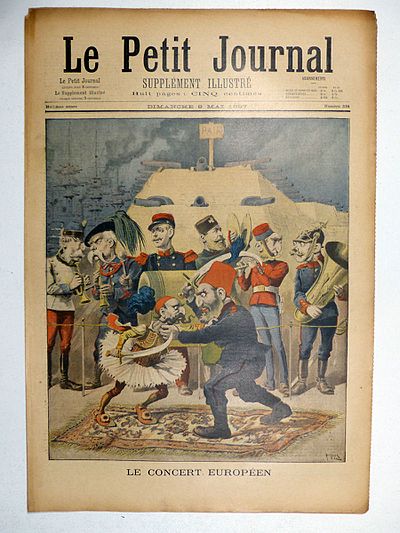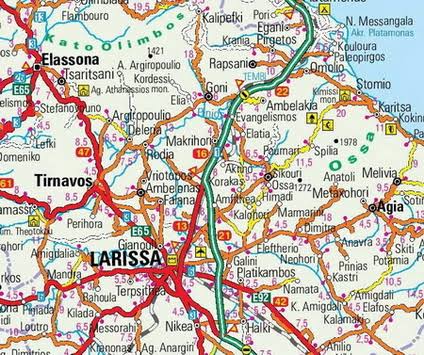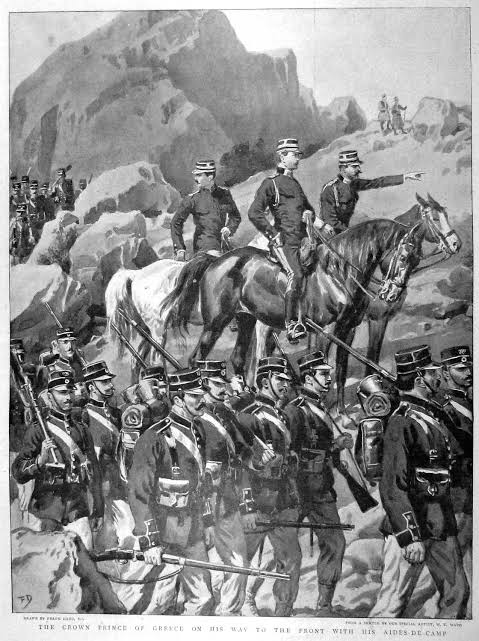summary of the war click here for a good description
of the war in full.

It seems to me that although the Greeks started this hostile activity,
they really had no certain ideas, decisions or goals in mind. Without
a fixed goal nothing can succeed and falling into hesistations will not
produce a good result. They divided their assembled forces into two
parts. At that time, the Greeks had 12 battalions, 3 divisions and 11
"Efzun" battalions. They were also able to form about 10 reserve
battalions.
The Greeks put a division with 15 battalions toward Yanya. So,
adding the "Efzun" and reserve battalions, the Greeks had assembled
two divisions with 16 battalions on the Thessaly border. One of these
divisions, the Makri Division, was situated in Yenişehir (Larissa) and
was reconnoitering the border from the Dava Pass toward Bey
Değirmeni. The other division, the Mavera Mihali Division, was
positioned in the south. There was also a detachment made up of 4
battalions and artillery under the command of Kaklamanos in the
vicinity of Nezerus.
After the Greek Army assembled in this manner, on 25-26 March
volunteers from Etniki Etriya (Ethnic Band) and French and Italian
volunteer groups attacked the outposts of our 5th Division. Evidently,
we were given the order to counterattack that same day but the order
was later rescinded.

Subsequently, there was also an attack on our 6th Division. When it
was determined that the attackers were not irregular volunteers but
rather regular Greek Army units, we finally issued a declaration of war.
Our main force began a counterattack, with the action taking place on
a broad front and lasting for about 30 hours. General Makri repulsed
the battalions at the Milona (Melouna) Pass and began an attack toward
Alasonya. At this time, a brigade from Memduh Paşa's division resisted
and drove the enemy from Milona, as 10 battalions from Hakkı Paşa's
division were brought there. In essence, since it makes sense to gather
forces where a victory has taken place, it was praiseworthy that Hakkı
Paşa's troops were moved.
Hakkı Paşa's forces, bolstered by a brigade from the 4th Division, were
tasked to threaten the line-of-retreat of the Kaklamanos detachment,
which was opposite our 6th Division, and thus open the way for the 6th
Division. Kaklamanos was able to preserve his line-of-retreat, though,
and on 10 April there was a battle on the front at Deliler. For this battle
Hakkı Paşa had 20 battalions. And although the enemy was in a weaker
position at the point of the battle, it was not unlikely that Greek reserve
units could be moved there.
So it became necessary for Hamdi Paşa's division to provide help to
Hakkı Paşa and for our other divisions to attack the enemy troops
opposite them to prevent them from being able to help their Greek
bretheren at Deliler. It is a strict and inalterable precept that whenever
an element of an army is engaged in battle, the other elements must
either provide assistance directly or prevent enemy elements from
getting involved.
This map, included with Ahmed İzzet Paşa's
lecture, shows the situation on the battlefield
on 18 April 1897. Yenişehir (Larissa) is the city
at bottom right and Alasonya (Elassona) is at
upper left (compare with current map below.)
However, this did not happen. Because the enemy's principle attack
was launched from the Milona ridges, we concentrated our forces there.
Repulsing the enemy there, we continued our attack toward enemy
territory. Consequently, since our basic plan was to attack from Bey
Değrimeni and Kalamas on our left flank, our initial defensive position
and the course of events resulted in a problem, in that it became
impossible to cut off the enemy's line-of-retreat and obtain a certain
victory. The enemy retreated and this battle on the border came to an
end on the night of 24 April.
tasked to threaten the line-of-retreat of the Kaklamanos detachment,
which was opposite our 6th Division, and thus open the way for the 6th
Division. Kaklamanos was able to preserve his line-of-retreat, though,
and on 10 April there was a battle on the front at Deliler. For this battle
Hakkı Paşa had 20 battalions. And although the enemy was in a weaker
position at the point of the battle, it was not unlikely that Greek reserve
units could be moved there.
So it became necessary for Hamdi Paşa's division to provide help to
Hakkı Paşa and for our other divisions to attack the enemy troops
opposite them to prevent them from being able to help their Greek
bretheren at Deliler. It is a strict and inalterable precept that whenever
an element of an army is engaged in battle, the other elements must
either provide assistance directly or prevent enemy elements from
getting involved.
This map, included with Ahmed İzzet Paşa's
lecture, shows the situation on the battlefield
on 18 April 1897. Yenişehir (Larissa) is the city
at bottom right and Alasonya (Elassona) is at
upper left (compare with current map below.)
However, this did not happen. Because the enemy's principle attack
was launched from the Milona ridges, we concentrated our forces there.
Repulsing the enemy there, we continued our attack toward enemy
territory. Consequently, since our basic plan was to attack from Bey
Değrimeni and Kalamas on our left flank, our initial defensive position
and the course of events resulted in a problem, in that it became
impossible to cut off the enemy's line-of-retreat and obtain a certain
victory. The enemy retreated and this battle on the border came to an
end on the night of 24 April.
The Greeks' operation was full of blunders during the aforementioned
battle. Given the location, the course of the battle was dependent on
their decisions and priorities. They had reserves available and we were
vulnerable to that. So it would have been possible for the Greeks to
have implemented a decision as they liked and gather the bulk of their
forces at the point of the primary attack. However, they left the entire
Maveru Mihali division idle, took a brigade away from the Makri
division and had only one brigade at Milona, which was their primary
point of attack. There can be no bigger mistake than this.
I can say that by making these mistakes the Greeks essentially handed
the victory to us on a silver platter. They left their right flank isolated
during the Deliler battle and in the aftermath of this engagement the
Greeks' strategic war position was seriously jeapordized. This was
because the fronts were quite extended and their right flanks were
badly broken by the succession of defeats they suffered.

Consequently, Prince Constantine gave the order for his soldiers to
withdraw to Yenişehir (Larissa). However, while this order may have
been sensible, its effect was to cause anxiety among his troops and
what should have been an orderly retreat turned into a mad rush to
the rear.
Because the Greek officers were preoccupied with internal political
matters, rather than their battlefield duty, they were unable to maintain
their calm and composure. Let me repeat that the Greeks' situation
happened because their officers were preoccupied with politics. I
should warn you, though, that Prince Constantine, relying on the
lessons learned from that time, has succeeded in cleansing this
danger from the Greek Army.

Crown Prince Constantine en route to the front,
1 May 1897.
//END of PART IV//
battle. Given the location, the course of the battle was dependent on
their decisions and priorities. They had reserves available and we were
vulnerable to that. So it would have been possible for the Greeks to
have implemented a decision as they liked and gather the bulk of their
forces at the point of the primary attack. However, they left the entire
Maveru Mihali division idle, took a brigade away from the Makri
division and had only one brigade at Milona, which was their primary
point of attack. There can be no bigger mistake than this.
I can say that by making these mistakes the Greeks essentially handed
the victory to us on a silver platter. They left their right flank isolated
during the Deliler battle and in the aftermath of this engagement the
Greeks' strategic war position was seriously jeapordized. This was
because the fronts were quite extended and their right flanks were
badly broken by the succession of defeats they suffered.
Consequently, Prince Constantine gave the order for his soldiers to
withdraw to Yenişehir (Larissa). However, while this order may have
been sensible, its effect was to cause anxiety among his troops and
what should have been an orderly retreat turned into a mad rush to
the rear.
Because the Greek officers were preoccupied with internal political
matters, rather than their battlefield duty, they were unable to maintain
their calm and composure. Let me repeat that the Greeks' situation
happened because their officers were preoccupied with politics. I
should warn you, though, that Prince Constantine, relying on the
lessons learned from that time, has succeeded in cleansing this
danger from the Greek Army.
Crown Prince Constantine en route to the front,
1 May 1897.
//END of PART IV//


Hiç yorum yok:
Yorum Gönder